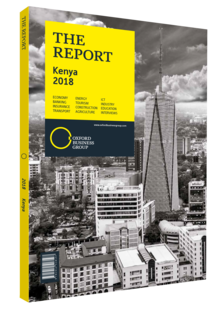Kenya's fixed-income securities market
Fixed income was billed as an attractive asset class in the capped-interest-rate era. This seems to be borne out by the fact that commercial banks increased their holdings of domestic debt by the equivalent of 2.23% of GDP in 2017, intensifying their grip on safer asset classes in lieu of riskier credit lending. Commercial banks accounted for 49.17%, or KSh947.8bn ($9.3bn), of domestic debt at end-2016; this increased to 50.67%, or KSh2.22trn ($21.6bn), by end-2017. This trend was further reflected in the dip in private sector credit growth, which closed 2017 at 2.4%, down from 18% over the preceding two years.
Secondary market turnover, meanwhile, dipped by a slight 1.21% to KSh429.5bn ($4.2bn) in 2017. Trading in government papers contributed 66.94% of the overall activity, while infrastructure bonds recorded a 32.54% share of total trade value. M-Akiba, the mobile-based retail infrastructure bond, had its maiden issue in 2017, recording KSh26.7m ($262,000), or 0.01% of the total.
What was notable over the course of 2017 was a reining in of yield indiscipline. This was brought to the fore with the cancellation of a 364-day Treasury bill (T-bill) at its first auction of 2017. The first primary bond issue was similarly cancelled. While no official reason was given, we surmise that the issue may have attracted overly aggressive bids or low investor appetite. Overall, the yield curve was upward-sloping and more symbolic of the segmented market hypothesis: commercial banks were dominant at the short-end, while insurance companies and pensions funds were active on the long-end. Nonetheless, the interest rate cap law had an effect on the longer end of the yield curve – in the 10- to 23-year space – which closed the year at a tighter spread of 35 basis points.
Optimism Remains
We maintain an optimistic outlook on fixed-income assets. For a start, we expect secondary market turnover to trend higher in 2018, as the calmer political situation helps to counter cautious sentiment and spur trading activity. Data for the first half of 2018 shows turnover of KSh298.5bn ($2.9bn), equivalent to 69.49% of the total in 2017. The government was under pressure in the first half of 2018 to plug the deficit in net domestic financing, which was mainly achieved by the uptake in T-bills. At the end of June, which also marked the end of FY 2017/18, net domestic financing of KSh273.1bn ($2.7bn) had surpassed the target by KSh25bn ($244.9m).
Longer-term Issuance
The Treasury has embarked on longer-tenor issues over 2018, which we deem a prudent measure to curb refinancing risk. However, the uptake of the longer-term papers has been subdued as investors have reduced duration amidst the current rate cap environment coupled with the unattractive yields.
We also expect and infrastructure bond (IFB) issuance in the fourth quarter of 2018. IFBs remain attractive to investors due to their tax-free nature and the ongoing need to finance infrastructural development. Indeed, the combined budget allocation for energy, infrastructure and ICT stood at KSh415.7bn ($4.1bn), or 4.80% of GDP in FY 2017/18, and KSh404.6bn ($4bn), or 4.13% of GDP, in FY 2018/19.
Secondary market trading and the performance of T-bills largely hinge on the prevailing condition of liquidity. With segmentation in the interbank market, liquidity distribution is still uneven across bank tiers, and the central bank has sought recourse to open market operations for liquidity management. We expect an acceleration in the establishment of a central depository for government securities that will provide collateral for horizontal repurchase transactions. This will result in improved credit line arrangements among banks.
Lastly, interest rate controls are likely to be prevalent, at least in the near term. As has been the trend since 2017, the spread at the longer-end of the curve has thinned, resulting in a flatter curve at the higher spectrum. We therefore expect a flat yield curve to continue over the fourth quarter of 2018, after Finance Act 2018 retained the upper ceiling of the interest rate cap.
You have reached the limit of premium articles you can view for free.
Choose from the options below to purchase print or digital editions of our Reports. You can also purchase a website subscription giving you unlimited access to all of our Reports online for 12 months.
If you have already purchased this Report or have a website subscription, please login to continue.

